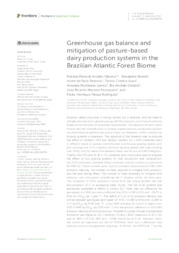Greenhouse gas balance and mitigation of pasture-based dairy production systems in the Brazilian Atlantic Forest Biome.
Greenhouse gas balance and mitigation of pasture-based dairy production systems in the Brazilian Atlantic Forest Biome.
Author(s): OLIVEIRA, P. P. A.; BERNDT, A.; PEDROSO, A. de F.; ALVES, T. C.; LEMES, A. P.; OLIVEIRA, B. A.; PEZZOPANE, J. R. M.; RODRIGUES, P. H. M.
Summary: Brazilian cattle production is mostly carried out in pastures, and the need to mitigate the livestock's greenhouse gas (GHG) emissions and its environmental footprint has become an important requirement. The adoption of well-suited breeds and the intensification of pasture-based livestock production systems are alternatives to optimize the sector's land use. However, further research on tropical systems is necessary. The objective of this research was to evaluate the effect of Holstein (HO) and Jersey?Holstein (JE x HO) crossbred cows in different levels of pasture intensification (continuous grazing system with low stocking rate?CLS; irrigated rotational grazing system with high stocking rate?RHS), and the interaction between these two factors on GHG mitigation. Twenty-four HO and 24 JE x HO crossbred dairy cows were used to evaluate the effect of two grazing systems on milk production and composition, soil GHG emissions, methane (CH4) emission, and soil carbon accumulation (0?100 cm). These variables were used to calculate carbon balance (CB), GHG emission intensity, the number of trees required to mitigate GHG emission, and the land-saving effect. The number of trees necessary to mitigate GHG emission was calculated, considering the C balance within the farm gate. The mitigation of GHG emissions comes from the annual growth rate and accumulation of C in eucalyptus trees' trunks. The CB of all systems and genotypes presented a deficit in carbon (C); there was no difference for genotypes, but RHS was more deficient than CLS (-4.99 to CLS and ?28.72 to RHS ton CO2e..ha?1.year?1). The deficit of C on GHG emission intensity was similar between genotypes and higher for RHS (?0.480 to RHS and ?0.299 to CLS kg CO2e..kg FCPCmilk?1). Lower GHG removals (0.14 to CLS higher than 0.02 to RHS kg CO2e..kg FCPCmilk?1) had the greatest influence on the GHG emission intensity of milk production. The deficit number of trees to abatement emissions was higher to HO (?46.06 to HO and ?38.37 trees/cow to JE x HO) and to RHS (?51.9 to RHS and ?33.05 trees/cow to CLS). However, when the results are expressed per ton of FCPCmilk, there was a difference only between pasture management, requiring ?6.34 tree. ton FCPCmilk?1 for the RHS and ?3.99 tree. ton FCPCmilk?1 for the CLS system. The intensification of pastures resulted in higher milk production and land-saving effect of 2.7 ha. Due to the reservation of the pasture-based dairy systems in increasing soil C sequestration to offset the GHG emissions, especially enteric CH4, planting trees can be used as a mitigation strategy. Also, the land-save effect of intensification can contribute to the issue, since the area spared through the intensification in pasture management becomes available for reforestation with commercial trees.
Publication year: 2022
Types of publication: Journal article
Observation
Some of Embrapa's publications are published as ePub files. To read them, use or download one of the following free software options to your computer or mobile device. Android: Google Play Books; IOS: iBooks; Windows and Linux: Calibre.
Access other publications
Access the Agricultural Research Database (BDPA) to consult Embrapa's full library collection and records.
Visit Embrapa Bookstore to purchase books and other publications sold by Embrapa.

